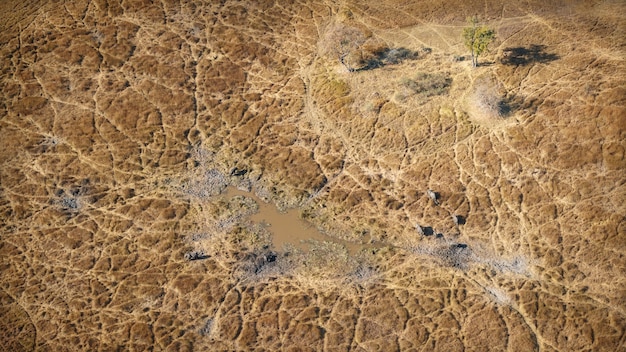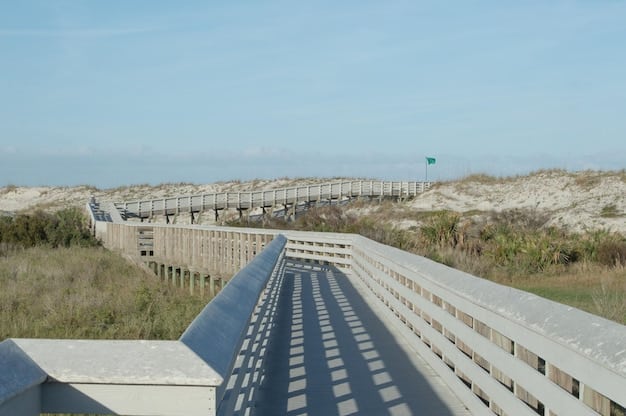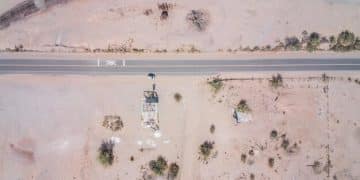How the US Military is Adapting to Climate Change

The US Military is proactively adapting to climate change by integrating climate risk assessments into strategic planning, investing in resilient infrastructure, and developing technologies to enhance operational effectiveness in a changing environment.
The US Military faces a growing challenge: climate change. From rising sea levels threatening coastal bases to extreme weather disrupting supply chains, the effects are far-reaching. The question is, how the US Military is adapting to climate change and its impact on national security?
Understanding the Climate Threat to National Security
Climate change is no longer a distant threat; it’s a present-day reality with significant implications for US national security. The Department of Defense recognizes climate change as a threat multiplier, exacerbating existing risks and creating new ones.
Direct Impacts on Military Infrastructure
Military bases, often located in coastal areas, are particularly vulnerable to rising sea levels and extreme weather events.
Impact on Global Operations
Climate change is contributing to instability and conflict around the world, requiring the military to respond to humanitarian crises and security threats in increasingly challenging environments.

- Rising sea levels threaten coastal installations.
- Extreme weather disrupts supply chains and training.
- Increased demand for humanitarian assistance strains resources.
The military must understand these multifaceted impacts to effectively adapt and maintain its readiness in a changing world.
Integrating Climate Risk into Strategic Planning
The US Military is taking proactive steps to integrate climate risk assessments into its strategic planning processes. This involves identifying vulnerabilities, assessing potential impacts, and developing strategies to mitigate risks.
Climate Vulnerability Assessments
The military conducts regular assessments to identify bases, infrastructure, and operations that are most vulnerable to climate change impacts.
Long-Term Planning Considerations
Climate change is now a key consideration in long-term planning, including decisions about base locations, infrastructure investments, and operational strategies.
- Identifying vulnerable assets and operations.
- Incorporating climate projections into planning scenarios.
- Developing adaptation strategies to address specific risks.
By proactively integrating climate risk into its planning processes, the military can make more informed decisions and enhance its resilience to future challenges.
Investing in Resilient Infrastructure
Recognizing the vulnerability of its infrastructure, the US Military is investing in resilient infrastructure solutions that can withstand the impacts of climate change.

Upgrading Existing Infrastructure
Existing bases and infrastructure are being upgraded to better withstand extreme weather events, rising sea levels, and other climate-related impacts.
Developing New Resilient Technologies
The military is also investing in new technologies and materials that can enhance the resilience of its infrastructure, such as flood-resistant building materials and renewable energy systems.
- Reinforcing coastal defenses against rising sea levels.
- Improving drainage systems to handle increased rainfall.
- Implementing energy-efficient and renewable energy solutions.
These investments are crucial for ensuring that the military can continue to operate effectively in the face of climate change.
Adapting Military Operations to a Changing Climate
Climate change is not only impacting military infrastructure but also transforming the operational environment. The US Military is adapting its operations to address these new challenges.
Extreme Weather Training
Military personnel are receiving specialized training to operate in extreme weather conditions, such as heat waves, floods, and wildfires.
New Operational Strategies
The military is developing new operational strategies to address the security implications of climate change, such as responding to climate-related disasters and conflicts.
Changes in climate patterns force the US Military to adapt quickly. They need to consider the challenges when operating in more extreme environments, and increased instability regions around the globe.
Adapting military operations to accommodate shifts in climate is an important step to keep military personnel safe and ready for duty. This also includes operational strategies to provide aid, should climate-related conflicts arise.
The Role of Technology in Climate Adaptation
Technology plays a crucial role in the US Military’s efforts to adapt to climate change. From advanced weather forecasting to innovative energy solutions, technology is helping the military become more resilient and efficient.
The military relies on weather data to prepare for missions. Modern technology helps improve climate and weather predictions, which can lead to safer and more efficient military duties.
- Advanced weather forecasting for improved planning.
- Renewable energy technologies to reduce reliance on fossil fuels.
- Innovative materials for resilient infrastructure.
By leveraging technological advancements, the military can enhance its ability to predict and respond to climate-related challenges.
International Cooperation and Climate Security
Climate change is a global challenge that requires international cooperation. The US Military is working with its allies and partners to address the security implications of climate change.
Climate change can be a catalyst for international tension. The US Military can work together with allies to prepare for changes and offer support to countries in need.
- Sharing best practices for climate adaptation.
- Conducting joint exercises to respond to climate-related disasters.
- Supporting international efforts to mitigate climate change.
Through international cooperation, the US Military can enhance its own resilience and contribute to global efforts to address climate security.
| Key Point | Brief Description |
|---|---|
| 🌊 Infrastructure Resilience | Upgrading bases to withstand rising sea levels and extreme weather. |
| 🔥 Operational Adaptation | Adjusting military operations to tackle climate-related challenges. |
| ☀️ Renewable Energy | Investing in renewable energy to reduce dependency on fossil fuels. |
| 🤝 International Collaboration | Cooperating with global allies to address climate security risks. |
Frequently Asked Questions
▼
Climate change contributes to rising sea levels and extreme weather, endangering coastal bases and disrupting military operations due to damages and accessibility issues.
▼
The military integrates climate risks into planning, invests in robust infrastructure, and adopts renewable energy, thus reducing reliance on conventional fuels.
▼
Technology improves climate forecasts and energy efficiency, enabling more resilient facilities and operational strategies against climate challenges.
▼
International cooperation facilitates the sharing of strategies and responses to climate-related disasters, essential for global climate security and stability.
▼
Climate change escalates global instability and stresses resources, altering operational environments and necessitating adjustments in training and strategic execution.
Conclusion
In conclusion, the US Military recognizes the profound implications of climate change and is actively adapting through strategic planning, infrastructure investments, and technological innovation. By integrating climate resilience into its core operations, the military is working to safeguard national security in a rapidly changing world.





